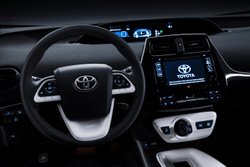Hybrid Sales Leader Promises Better Fuel Economy & Better Handling
A new Prius is a big deal, so Toyota can be excused for trying to make a big Las Vegas show out of the reveal of the fourth generation of the iconic hybrid. The new model descended from the “sky” as if some avatar for good fuel economy, but also demonstrated what can only be described as aggressive styling—and here’s the unfortunate caveat—for a Toyota.
Therein lies the conundrum. Here is a company known for producing massive quantities of high-quality, mildly styled vehicles introducing a brand-new model of the poster child for

environmental performance. The new emphasis—“no compromise,” “fun-to-drive dynamics,” “emotional styling.”
Not that the environmental bona fides have been left by the wayside. The 2016 Toyota Prius, when it arrives late this year or early next, is promised to deliver 10 percent better fuel economy than the current model. An Eco model promises even more than that. The improvements come, in typical Toyota fashion, from a multitude of sources:
- Smaller, lighter hybrid components,
- Higher energy density in the batteries,
- Improved thermal efficiency in the gasoline engine, and
- Unspecified improvements as one of the first examples of Toyota’s New Global Architecture (TNGA).
Bill Fay, group vice president and general manager of the Toyota Division, noted that each generation of the Prius got a little bit better, a great example of Toyota’s incremental system and something this Prius seems to epitomize one of the main reasons behind eight million hybrid sales worldwide. People know what they’re getting with a Toyota and know what they’re getting with a Toyota hybrid.

However, Toyota also wanted to present the new Prius with the theme – “It’s not just about MPG anymore” – pushing its new styling and upgraded suspension package. Of course, no media present in Las Vegas got to drive the new 2016 Toyota Prius. That will come later, closer to its on-sale date. At that point the validity of the performance claims—both handling and fuel economy—will be put to the test.
We believe the Prius is “just about MPG,” but that new styling and better handling could be just what’s needed to halt a several year sales slide for the five-door hybrid’s basic model. You could argue the sales drop is a result of Toyota’s proliferation of hybrid models, but the overall hybrid market is down about 20 percent during the first two-thirds of the year compared to 2014. It will be interesting to see if a new “no compromise” version of the best-selling model in the segment can lift it back up.
Related Stories You Might Enjoy:
Road Test: 2014 Toyota Prius Liftback vs. Toyota Prius Plug-in
Road Test: 2014 Toyota Prius c vs. Toyota Prius V
First Drive: 2016 Toyota Mirai Fuel Cell Electric Car

5 thoughts on “Unveiled: The 2016 Toyota Prius”